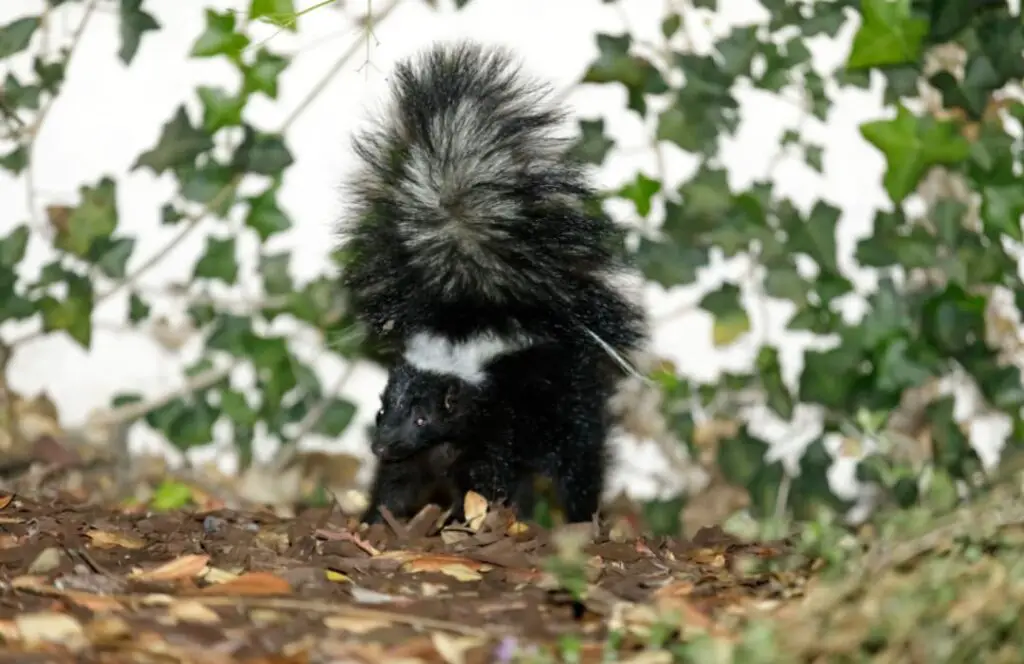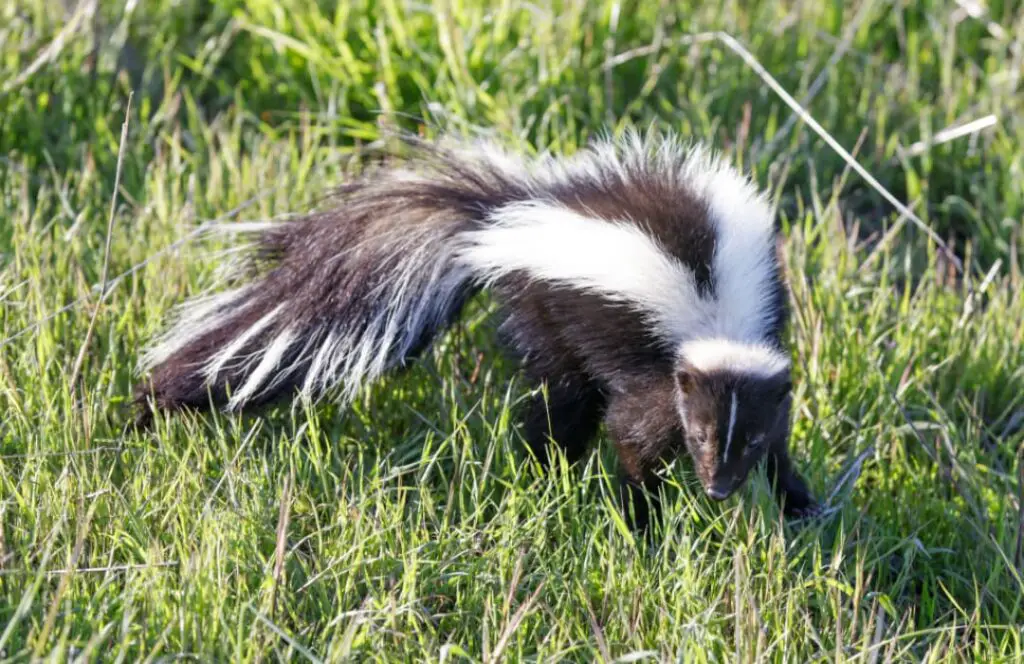Skunks are notorious for their pungent and infamous defense mechanism – their spray.
These small, nocturnal creatures might look cute, but getting a dose of their unmistakable odor can definitely change your day – or month! And not for the better!
Knowing how far a skunk can spray is essential for those who live in areas where skunks are common, as it can help keep a healthy distance and avoid any surprise encounters with these animals.
Most skunks can accurately spray up to 15 feet; however, the range of the spray can vary depending on the species. And don’t forget that the spray can easily waft in the breeze, coming at you when you least expect it.
The striped skunk, the most commonly encountered species in North America, is known to spray up to 8 feet, but the safe zone would necessarily be much further than that if you ever run into one while walking about. In addition to the striped skunk, there’s also the hog-nosed skunk and the spotted skunk.
Although the skunk’s spray is not harmful in the long run, it can cause significant eye irritation and temporary blindness.
Skunks only resort to releasing their smelly weapon when they feel threatened, making it crucial to maintain a safe distance and avoid putting them in a defensive position.
The Nature of Skunk Spray
Anal Glands or Scent Glands
Skunks have two glands located beneath their tails, which produce the spray. These glands store the spray as a liquid, which the skunk can eject with great accuracy.
When a skunk feels threatened, it can voluntarily contract the muscles surrounding the anal glands, causing the fluid to be released through small ducts and out of the skunk’s anus.
Sulfur-Based Compounds
Skunk spray is composed of sulfur-based compounds that give it its notoriously strong and unpleasant odor. The primary compounds in skunk spray are thiols, which contain sulfur and hydrogen atoms.
These compounds easily bond with other substances and produce a pungent smell that is difficult to remove.
Thiols
As mentioned earlier, thiols are the primary compound found in skunk spray. They are responsible for the distinct, pungent smell that can linger for days or even months after the spray has been released.
Thiols are powerful enough to cause irritation and temporary blindness to those who come into contact with the spray, further emphasizing its effectiveness as a defense mechanism.
Musk
The musk is another component found in skunk spray. It contributes to the powerful and unpleasant odor, working in tandem with the thiols to repel potential threats.
Skunks typically have a small amount of musk stored in their anal glands, which they can release in sprays when they feel threatened.
After using up their musk supply during a defense situation, it can take up 10-14 days for skunks to replenish their reserves, leaving them temporarily more vulnerable to predators.
Understanding the Skunk’s Defense Mechanism

Spraying as a Warning
Skunks use their spray as an effective tool for warding off potential threats. They only spray when they feel cornered or threatened, as their last line of defense.
A skunk is more likely to try and preserve its stores of the precious fluid, rather than wasting it on creatures (including humans) that don’t pose an immediate threat.
Temporary Blindness
When a skunk sprays a potential threat, the spray is aimed at the eyes. The chemical compounds in the spray can cause temporary blindness and a strong odor that can last for several days.
This effect occurs because the thiols irritate the eyes and mucous membranes. The temporary blindness can last from a few minutes to several hours, depending on the severity of the spray exposure.
This serves as an effective deterrent, as it incapacitates the predator and allows the skunk to escape to safety.
Facing Predators
Skunks are relatively small and vulnerable animals, so they rely heavily on their spray to keep predators at bay. When a skunk senses danger, it will often try to walk away and avoid confrontation.
If a predator or threatening animal continues to approach, however, the skunk will raise its tail, stamp its front feet, and hiss as a warning, signaling that it is about to spray. (Which I personally consider to be a very kind gesture.)
In the face of multiple predators, a skunk may spray multiple times, with the ability to spray up to six times in a row. Remember that their spray is their primary defense mechanism, so they will try to conserve the precious fluid and only use it when necessary.
If you ever encounter a skunk, give it space and respect, and you will likely avoid a smelly encounter.
Range and Accuracy of Skunk Spray
Distance
As we’ve seen, skunks can accurately spray up to 15 feet (4.6 meters) away. The common striped skunk of North America, typically sprays in the range of about 8 to 10 feet (2.5 meters).
It’s important to note that skunk spray can travel much farther when it’s windy. In many cases, you might be able to smell it up to 1 mile (1.6 km) away.
Accuracy
Skunks have a remarkable level of accuracy when it comes to spraying their target. They can accurately spray their smelly fluid at a potential predator or threat, which is essential for their survival.
Since they can only spray about 5 to 6 times in a row, they need to make each shot count.
It’s interesting to know that skunks usually don’t spray each other, preferring to reserve their secret weapon for other species.
When encountering a skunk, keep in mind their impressive range and accuracy, and remember to remain calm and slowly back away to avoid any unpleasant surprises.

Impact on Pets and Humans
Risks for Pets
Skunk spray can cause a range of issues for pets, especially dogs who tend to be curious and get a little too close. When a skunk sprays a pet, the spray can be extremely irritating and uncomfortable.
Some common reactions in pets include:
- Sneezing
- Rubbing their face on the ground
- Drooling
- Temporary blindness
- Vomiting
While skunk spray is not poisonous, its noxious odor can cause significant respiratory discomfort for pets, especially if they have pre-existing respiratory conditions.
It is essential to clean and deodorize your pet as soon as possible to minimize the effects of the spray.
Risks for Humans
While humans may maintain a greater distance from skunks, they can still experience the unpleasant effects of skunk spray. In addition to the strong odor, skunk spray can be irritating to the eyes, nose, and throat if inhaled.
Here are some possible effects of skunk spray on humans:
- Watery eyes
- Nasal irritation
- Difficulty breathing
- Headaches
- Nausea
Dealing with Skunk Spray
Removing Skunk Odor
If you or your pet has been sprayed by a skunk, it’s important to act quickly to remove the foul odor. One effective method for removing skunk odor is to use a homemade solution consisting of:
- 1 quart of 3% hydrogen peroxide
- 1/4 cup of baking soda
- 1 teaspoon of liquid dish soap
Mix these ingredients in a large open container and use a cloth to apply it to the affected area. Be cautious not to get the solution in your eyes, and do not store the mixture in a closed container, as it can build up pressure and burst.
Work the solution into the fur or fabric, and let it sit for about five minutes before rinsing thoroughly with water. Due to the volatile nature of the chemicals in skunk spray, it’s sometimes necessary to repeat this process for complete odor removal.
Another common remedy is to use tomato juice. Although tomato juice might help mask the smell, it is not as effective as the hydrogen peroxide mixture in completely neutralizing the odor.
How Long Does Skunk Odor Last
The duration of skunk odor largely depends on the strength of the spray, as well as the steps taken to remove it. In some cases, the odor can linger for days or even months if not properly treated.
Promptly addressing the skunk spray with the suggested cleaning methods mentioned above will help minimize the odor’s longevity. Keep in mind that it might take multiple attempts to fully remove the smell, especially from porous materials like clothing and upholstery.
In summary, dealing with skunk spray is manageable when using the right cleaning methods. For the best results, address the odor quickly and thoroughly to neutralize the skunk spray as effectively as possible.
Additional Information About Skunks
Nocturnal Behavior
Skunks are known for their nocturnal behavior, which means they are most active during the night. This is primarily due to their natural instincts to hunt for food and stay safe from predators.
It’s crucial to be cautious during nighttime hours, as encountering a skunk in the dark could lead to a spray situation.
When are Baby Skunks Born?
Baby skunks, also known as kits, are born in the spring, typically between May and June. A mother skunk will give birth to a litter that can range from four to seven kits. These babies stay with their mothers for about two months before venturing out on their own.
Baby skunks are vulnerable to predators, but with their mother’s guidance and protection, they learn essential survival skills for their future.
Den Sharing in the Winter
One little-known fact about skunks is that they have a unique social behavior called “den sharing.” In the winter, when temperatures drop, skunks will often share their dens with other skunks to conserve warmth. This behavior is especially common among females and their young, who will often share dens with other females and their offspring.
What’s interesting about this behavior is that skunks are generally solitary animals, and den sharing is not commonly observed in other species of mustelids (the family of carnivorous mammals that includes skunks, weasels, and otters). It is believed that den sharing may have evolved as a way for skunks to increase their chances of survival during the winter, when resources are scarce and the risk of predation is high.
In addition to providing warmth and protection, den sharing may also have social benefits for skunks. By sharing dens, skunks can form social bonds and establish dominance hierarchies, which may help them to compete for resources and mates in the future. Overall, den sharing is a fascinating behavior that highlights the complexity and adaptability of skunk social behavior.
Rabid Skunks
Rabies is a virus that affects mammals, including skunks. While not all skunks carry rabies, they are one of the most commonly reported rabid wildlife species.
If you encounter a skunk acting strangely, such as showing aggressive behavior, unprovoked attacks, or roaming during daylight hours, it could be a sign of rabies.
If you suspect a skunk is infected with rabies, it’s essential to stay away from the animal and report the situation to your local wildlife authority.


